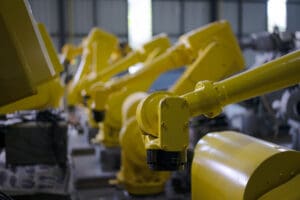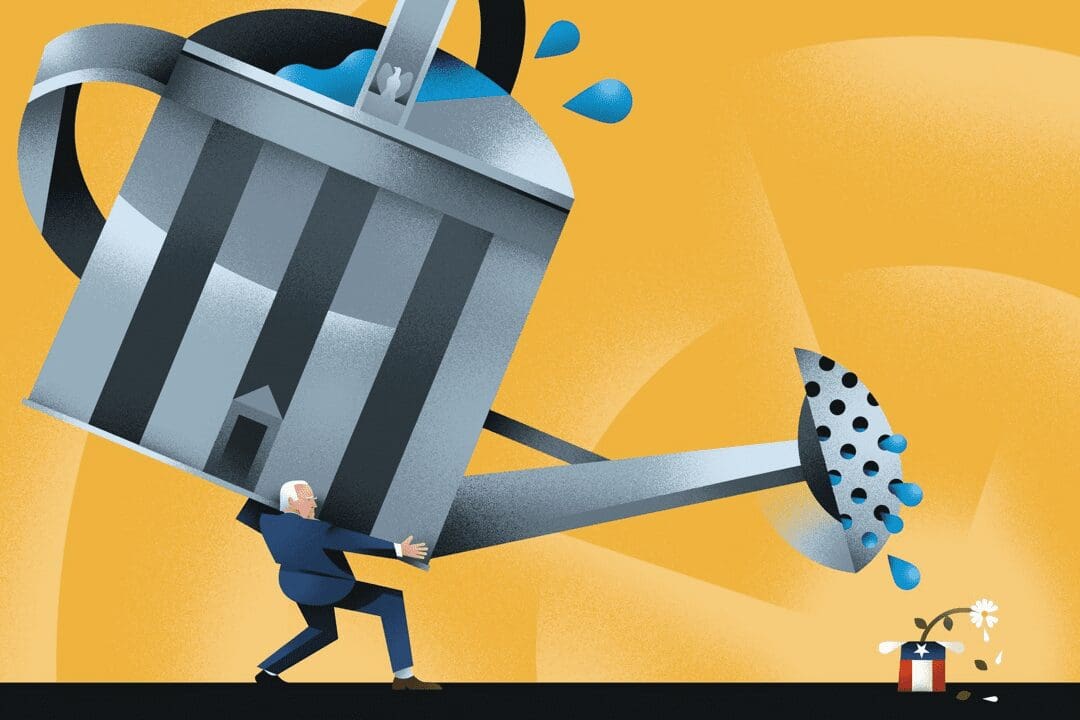The country is in desperate need of a massive economic recovery program. The incoming administration shouldn’t hold back.
By: Robert Hockett, Aaron James
The last four years have seen no shortage of irony, but it still spins your head to think that the incoming administration might turn out to be more fiscally conservative than the last one. Ted Kaufman, the former Delaware senator said to be one of the most influential members of President-elect Joe Biden’s transition team, is worried about the federal budget deficit. “When we get in, the pantry is going to be bare,” he lamented in August. “When you see what Trump’s done to the deficit … with the incredible tax cuts. So we’re going to be limited.”
In contrast, Federal Reserve Chairman Jerome Powell, who was appointed by Donald Trump, isn’t talking about empty pantries or deficits or the looming threat of inflation. He has argued that we needn’t worry about our low (indeed, effectively negative) interest rates until forever. And he’s right.
Biden has proposed that we “build back better” with new public investment in infrastructure, innovation, clean energy, working families, small businesses, and education. This is the correct agenda.
The problem is that this agenda is just not compatible with Kaufmanomics, which is synonymous with decades of mainstream Democratic thinking on spending, debts, and deficits. Despite the emergence of robust new approaches to deficit spending, hoary notions about the issue continue to linger in Washington, D.C., like a stale smell. “My major concern is inflation,” former Fed Chair Alan Greenspan opined recently. “It obviously hasn’t emerged in any significant way yet but that’s where the problems lie.”
Greenspan fretted that more federal spending will “crowd out” productive investment—as if, with over 10 million unemployed and consumers short on money much as during the Great Depression, businesses were just waiting for Uncle Sam to “get out of the way.” Kaufman, for his part, seems to view investment capacity in general, and public capacity in particular, as being like a jar of peanut butter. There’s only so much in the jar, and when the bulk of it is gone, we’re left rebuilding the country with what’s left sticking to its sides.
In fact, we have all the institutions we need to begin a full national reconstruction: a Treasury; a Fed; and multiple Cabinet-level agencies with jurisdiction over energy, the environment, transportation, communications, education, water, and countless other infrastructures and industries.
Some of these agencies have spending authority, and others—notably the Department of Education—have a fiscal equivalent, such as debt forbearance and even forgiveness authority. But beyond calls for student debt cancellation, you don’t hear much about how to use this immense national fiscal capacity, a legacy both of our early history and of the New Deal, from cupboard crawlers who’d rather scrape empty jars.
We also have all the money we need to do these things. That’s because money’s not like peanut butter. Many still seem to think of money as some sort of fixed physical substance, maybe because it once had something to do with gold, silver, and other scarce “money-stuffs” that could be depleted. But money—especially the “fiat money” that has made up most sovereign currencies over the past century—just isn’t like that. Money is a sort of promise; indeed, the dollar bills in your pocket are known as “Federal Reserve notes” (take a look, right along the top). “Note” here is legalese for “promissory note.”
Reflect upon this for a moment. How many promises can you make? What are the limits? Is it about how many promises you can literally make or about how many promises you can fulfill? Sure, you can overcommit—promise to do more than you’re actually capable of. You can also under-commit, keeping your options open and thereby impoverishing your life by sitting on your potential.
Money is like that. Nations can under-issue money and thereby impoverish themselves by under-committing. We call that deflation. Nations can also overissue money and thereby harm their own credibility, as any overpromiser does. We call that inflation.
But the key to inflation, and to deflation, is the relation between promising and the capacity to fulfill promises. That’s how money works. Currency inflates when its supply grows faster than supplies of what it’s used to purchase—i.e., too much money chasing too few goods. It deflates when its supply grows more slowly than do supplies of what it’s used to purchase—too little money chasing too many goods. The Goldilocks balance is the state of affairs in which money supplies on the one hand, and goods supplies and productive capacity on the other hand, grow in tandem.
The Goldilocks balance is the state of affairs in which money supplies on the one hand, and goods supplies and productive capacity on the other hand, grow in tandem.
And that’s the magic of public money, the alchemy of public finance. Because then even big, well-directed public investment is—by definition!—not inflationary. The new money, simply spent into existence by our money-issuing federal government, creates the very means of its own absorption. This observation is the key to an economic recovery program that can be both ambitious and noninflationary—a program that will truly see the United States build back better.
These questions are hardly academic. While Biden has several options for juicing the economy through executive action (which we outline below), he will still have to deal with moderate Republicans and moderate Democrats in Congress if he wants to enact even a fraction of his agenda. That will mean that he can’t cave to deficit hawks on the crucial question of whether a large deficit is bad for the economy. Republicans themselves have all but admitted the specter of expansion-killing deficits is a fiction by passing a raft of tax cuts that did little but line the pockets of the wealthy and explode the very deficit they now seem so keen on bringing down. If Biden wants to enact a successful recovery program, he will not just have to adopt the right policies but also change the way Washington thinks and talks about spending once and for all.
We all can agree that federal spending matters and that inflation can, in some circumstances, be dangerous. This was the victory achieved by what’s known as the Great Moderation: 30 years of low consumer price index inflation in the aftermath of the stagflation of the 1970s. What the Great Moderationists ignored, however, were the massive bouts of hyperinflation in the form of asset price bubbles outside of the index raging throughout the Clinton era and beyond: first in the stock market, then in tech stock specifically, and finally in housing and housing-associated markets. There could be no better example of capital misallocation, involving trillions of dollars thrown into mere speculation. It is why the economist Robert Shiller dubbed it an era of “irrational exuberance.”
Like all hyperinflations, the Clinton- and Bush-era asset price inflations were credit-fueled. What Greenspan, then the Fed chair, and his friend Larry Summers, the Clinton Treasury secretary, should have done was to crowd out that merely speculative expenditure with productive investment; or else rein it all in through taxation, interest rate hikes, and Treasury sales; or pursue some combination of both. All in the name of impounding that excess credit then flowing to speculative asset markets and redirecting it to actual productive investment: investment that fuels the production of real, not paper, wealth.
Alas, they did the contrary—a policy that was not only wrong but fully 180 degrees wrong—by lowering taxes, lowering rates, and buying back federal debt. (The buyback itself started a barely stemmed crisis in 2000, when market traders began fearing a shortage of that safest of “safe assets” known as U.S. Treasury debt.) This is called pro-cyclical monetary policy, which uses central bank tools to reinforce rather than counteract volatile price swings. No wonder the economy bubbled, then crashed in 2008. And now here we are, threatened with going pro-cyclical again, as Greenspan and Kaufman preach belt-tightening to famine victims.
But, again, we can spend big if the money flows to the right places. How do we get it there?
Let’s start with where we are now. Disasters like the present pandemic not only impose costs but also deprive us of the usual means of paying these costs. The same rolling catastrophe that is draining our states’ and their cities’ coffers is freezing productive and service activities. It is also weakening businesses and property values, the taxation of which normally replenishes those coffers.
State treasuries and private sector banks, which lend only on the prospect of things getting better, not worse, are left impotent by disasters like this one. Our national fiscal and monetary authorities—the Treasury and the Fed—are therefore the only game in town. As Biden helpfully reminded us in the second and final presidential debate, our nation’s Founders “were smart” to allow “the federal government to deficit-spend to compensate for the [states’ not being able to].”
The very point of a fiscal union with power to borrow and spend is in part to enable national investment for all states and cities regardless of circumstance. And key to the whole system is that word investment, which is not the same as mere spending.
The very point of a fiscal union with power to borrow and spend is in part to enable national investment for all states and cities regardless of circumstance.
Contrary to the Republican stigma against spending, which implies wasted money, investment is all about spending now to get more later. As long as that “more later” is reasonably assured, investing is worth the candle—it’s what financiers call “NPV positive,” possessed of a net present value that’s in the black, not the red.
What does this mean for our current predicament? It means Fed-supported Treasury spending—through economic relief and rebuilding packages authorized by Congress—along with the promised but not yet delivered Treasury and Fed support of state and local spending. Done right, this is investment spending in the fullest sense of the word—spending that itself generates the means of paying along with future growth (and taxation on that growth). It is not spending that will result in too much money chasing too few goods, since all that money will be plowed back into the system.
The trick is to make sure this spending is a bona fide public investment, not an unproductive gravy train for friends of the White House or legislators or for Jeff Bezos.
How do we do that? Let’s start with immediate needs, then look ahead to next year.
Since April, Congress and the Fed have been promising to keep states and cities afloat by sending them grant money and purchasing their bonds, respectively. So far, there have been only limited congressional appropriations and there have been next to no takers of Fed funding, for reasons we will explain.
So, for starters, just make debt financing unnecessary for our states and their subdivisions—by having Congress appropriate funding for them, as this summer’s Heroes Act, passed by the House, would do.
If Congress fails to act, or if yet more is needed, the next thing to do is drop the “market rates” and “penalty rates” now associated with Fed Municipal Liquidity Facility lending, which requires no further legislation. These rates have gratuitously discouraged municipal borrowing of authorized Fed funds. Thus far, only Illinois and New York’s Metropolitan Transit Authority have availed themselves of the facility—seven months after its opening! Penalty rates are fine for reckless “too big to fail” banks but not our very own public agencies, which are plenty cautious and exceptionally hard-hit right now because of the pandemic. These loans will ensure that municipalities can keep workers on their payroll, stimulate the economy, and provide essential services.
Treasury Secretary Mnuchin has decided—callously and unwisely—not to renew the Cares Act “equity investment” in the MLF facility at the end of the year. A new Biden administration Treasury can renew it, or the Fed can simply continue the program under different legal authority (using its Federal Reserve Act Section 14 bond-buying authority instead of its Section 13 emergency authority). The Fed should in fact go that latter route now, at least until Biden takes office, to stave layoffs of public employees by hard-pressed cities and states, and the further contractions that this will entail.
Next, distribute administration of these groundbreaking programs across all of the regional Feds—in other words, spread the Fed. This is why we have regional Feds in the first place, 12 of them in total. At the moment, the MLF is run entirely out of New York, two blocks from Wall Street, where even the best civil servants know little about the needs of Billings, Montana, or Watts in Los Angeles.
How else can Congress, the Fed, and the Treasury take national action?
Well, forgiving student debt is a start—as one part of a larger plan to help non-college-educated Americans as well. We can also give payments to people who are unemployed, provide universal health care, and raise minimum wages. Ideally, we’d pay small businesses to stay closed, so they can reopen when a vaccine has been made widely available. And we would subsidize their continuing to pay those employees—a strategy that has proved quite helpful here since the onset of the pandemic in March.
Some of this, apart from the debt forgiveness, likely requires the approval of Congress, which has shown little appetite for more pandemic assistance, but at least we will now have a champion for such assistance in the White House. If Democrats win two crucial Senate races in Georgia, they may even have a shot of enacting the bulk of this agenda.
But all of the above should be considered the bare minimum in any event, and in economic terms it is merely good Keynesian stimulus, which even moderate Democrats like Kaufman understand. We have to think beyond that, too, toward a full national reconstruction that will require new economic ideas and actions.
The nation’s physical infrastructure—from power grids to transport and communication networks—is literally decades out of date. Our industries, once the envy of the world, are backward and at best second-rate in all but a few fields. So we must nurture the industries of tomorrow—including in renewable energy sources like solar and wind—creating “clean jobs” in the Rust Belt and all over the country. And of course, there’s a planet to save, a world that will burn us if it doesn’t first drown us or kill us with storms.
The nation’s physical infrastructure—from power grids to transport and communication networks—is literally decades out of date.
This is precisely why President-elect Biden has spoken of spending trillions of dollars to “build back better.” Fortunately, much of what must be done can be done by executive action, with or without Congress.
How so? To start with low-hanging fruit, use government procurement—now to the tune of a half-trillion dollars—to buy renewable energy in corporate power purchase agreements and remake the electricity grid by encouraging new projects.
And since we should be systematic about these and other measures, convene a National Reconstruction and Development Council comprised of the heads of all existing Cabinet-level executive agencies with jurisdiction over infrastructure and industry. Then enlist the Federal Financing Bank that already exists within Treasury to help federal agencies finance new projects—some with loans, some with grants, some with equity investments, some with mixed public-private participation, and some with combinations of all these.
Finally, as we spread the Fed, the Fed system of regional banks should be restored to its original 1913 design for nationwide development finance. The Fed’s original mission was production-focused in precisely this way. The regional banks would monetize commercial paper issued by small businesses and what we now call start-up firms to facilitate even development across our full continental republic. The Federal Reserve Board in Washington, D.C., would coordinate these activities “macroprudentially,” to avoid both excessive (hence inflationary) and insufficient (hence deflationary) credit dissemination nationwide. The pandemic has forced the Fed to begin to return to this original development mandate, but it will be easy for the new Biden administration to restore it fully to what its founders (Carter Glass of Glass-Steagall fame among them) had in mind.
Do these three big things, then—establish a reconstruction and development council (the NRDC), finance its projects through the Treasury (the Federal Financing Bank), and “spread the Fed”—and we’ll have all federal instrumentalities we need for continued national development. None of it requires new legislation, as nice as that would be. With these institutions, we could begin planning, and executing, massive strategic investment in new infrastructures and industries at once.
If some in the Biden administration remain scared of inflation, at least they will be asking the right question (will we inflate?) rather than the absurd question (how do we pay?)—to which everyone should know the answer (with money). But the administration needn’t worry. For inflation won’t happen from productive public investment.
To invest (not merely “spend”) money is to spend it in counterinflationary ways: to produce what the money itself is then spent on. New spending creates new money. When we build a new aircraft carrier, the dollars are simply issued by the Fed to reserve banks that make payments to contractors for all the steel, the welders, and so forth. But the new money isn’t inflationary automatically: Everything depends on where it is spent. It won’t bid up prices on the same stock of goods and services—with too much money chasing too few goods—if it creates new goods and services in abundance.
And when we invest in new plant and equipment, for example, not to mention new industries, we are accomplishing just that: investing in our own productive capacity—our own ability to produce in abundance those goods that new money will be spent on. Create money for solar panel construction and installation, and we get far more solar panels and installations, which help absorb the very money invested, stabilizing or even reducing prices. This is why true public investment is often said to be “self-liquidating,” unlike tax cuts at the top of the wealth-distribution ladder.
It’s also important to remember that this country is still in its so-called Great Moderation where consumer price index inflation is concerned. There’s no reason to think that will change. Indeed the Fed has consistently come in under its 2 percent inflation target for 12 years now and is still (unsuccessfully) trying to get up there from below. Deflation, not inflation, in other words, remains our most pressing monetary problem. And if you check the exceedingly narrow market spread between ordinary Treasury prices and inflation-protected Treasury prices—a market measure of inflation expectations—you’ll see that the market sees no inflation worries ahead, either.
Finally, the Fed has ample tools—including new tools that Congress could give it—to end inflation easily should it ever, however improbably, emerge.
All that we need is the right degree of imagination and will—the will to build back better. Ending our pandemic is just the beginning. We’ll need far more public spending to repair our social compact, restore our republic, and begin to face up to our even bigger climate crisis.
___________________________________________________________
About the Authors:
Robert Hockett is a professor of law at Cornell University. He is the co-author of Money From Nothing.
Aaron James is a professor of philosophy at University of California, Irvine. He is the co-author of Money From Nothing.
See original article in New Republic here: https://newrepublic.com/article/160401/joe-biden-can-stop-worrying-start-spending-like-crazy




















